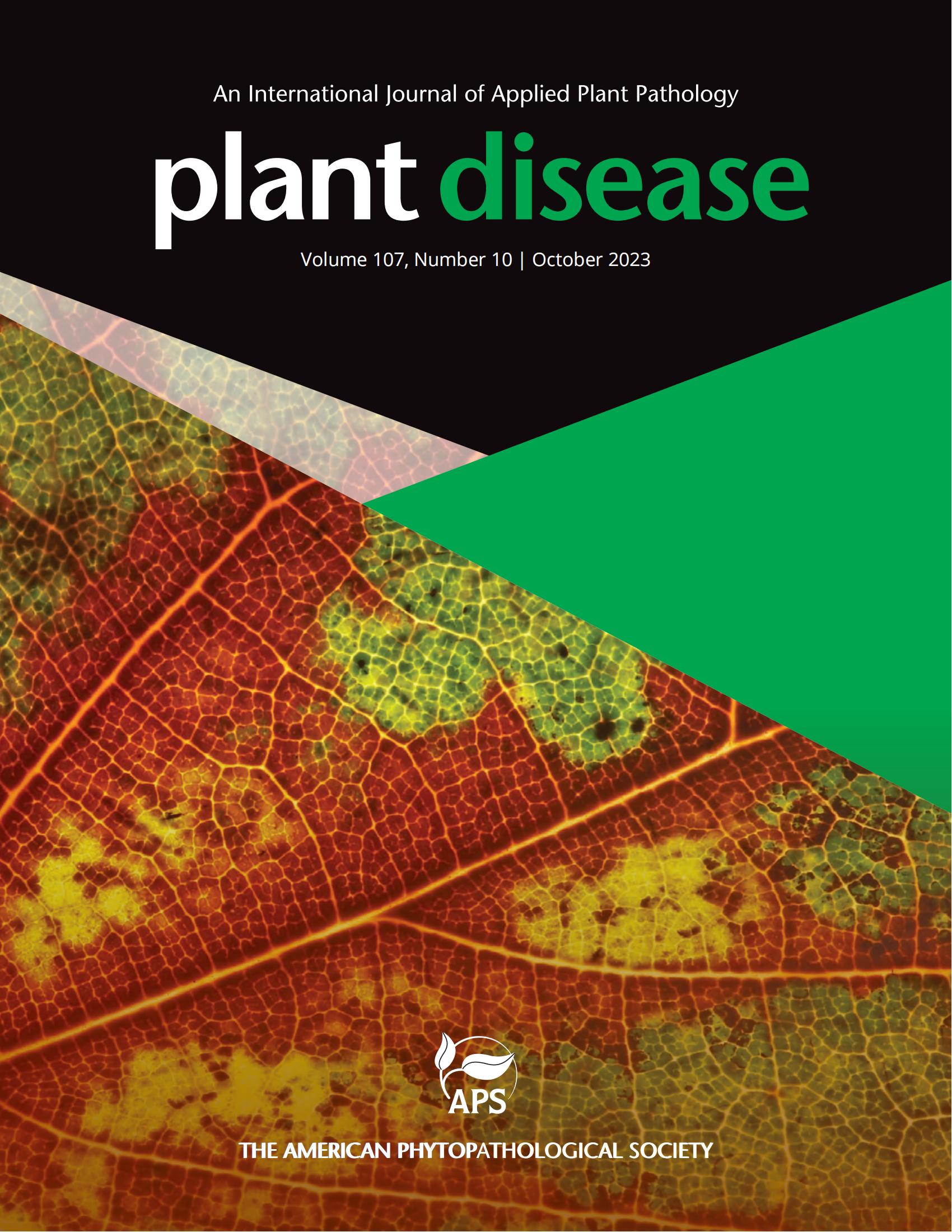金银花根腐病病原菌研究初报。在中国。
摘要
金银花;是一种广泛种植的中药材,具有很高的经济价值。2024年5月,在重庆市万州区(30°23′50″N, 107°52′22″E)龙居镇、白图镇和高梁镇的商业种植中,观察到一种粳稻根腐病的症状。感染植株地上部分完全坏死,根系木质化减弱,发病率为45% ~ 70%。为鉴定病原菌,采集17株病株的根组织,75%乙醇表面消毒30秒,5% NaClO浸泡1分钟,无菌水冲洗3次,无菌吸湿纸干燥,置于马铃薯葡萄糖琼脂(PDA)上,28℃暗箱培养。5天后,95%的样本产生了相似的菌落。选取单个分离物B1-V1进行形态和分子表征。在PDA上28℃孵育15天后,B1-V1菌落直径达到80 mm;白色菌丝体生长在略高于平板表面的地方,质地柔软,并产生黄色色素。菌丝透明、隔生,生分生孢子呈帚状分枝,分生孢子透明、椭圆形,单个分生孢子大小为(2.31 ~ 4.75)× (5.33 ~ 8.75) μm (n = 32)。形态学与先前对rosea Clonostachys的描述一致(Wang et al. 2024)。通过引物ITS1/ITS4 (Wang et al. 2024)、T1/βt2b (Wang et al. 2024)扩增内部转录间隔区(ITS)、β-微管蛋白基因(TUB2)和RNA聚合酶II基因第二亚基(RPB2)。和RPB2F/RPB2R (Long et al. 2021)。B1-V1对应的序列提交到GenBank,登录号为PV368674 (ITS), PV390661 (TUB2)和PV390662 (RPB2)。BLAST检索结果显示,该病原菌与菌株GY12 (ITS: OR789466.1,鉴定值为545/545 bp)、JABY1 (TUB2: OP868694.1,鉴定值为601/617bp)和HZL-6-8 (RPB2: PP486409.1,鉴定值为896/900bp)的序列相似性最高。利用MEGA7软件采用Maximum Parsimony方法将ITS-TUB2- rpb2序列进行串联,构建系统发育树,结果表明该分离物与玫瑰玫瑰菌株TMB亲缘关系最近(ITS: 491/498bp, TUB2: 311/455bp, RPB2:753/753bp)。为证实其致病性,两根扦插均来自于2年生粳稻的枝条。一年的植物(每组n = 6)用75%的乙醇进行表面消毒。用无菌针伤根,并在4 × 10⁷分生孢子/mL分离物B1-V1悬液中浸泡20天。接种后出现叶片萎蔫、发黄、褐变、腐病等症状,新根数量显著减少。从有症状的根中重新分离的菌落在形态上与原始接种物一致,从而满足Koch的假设(Wang et al, 2024)。据我们所知,这是第一次报道玫瑰念珠菌引起枇杷根腐病。为今后该作物根腐病的防治提供了重要依据。Lonicera japonica Thunb., belonging to Caprifoliaceae, is a widely cultivated traditional Chinese medicinal plant with high economic value. In May of 2024, symptoms of a root rot disease were observed on L. japonica in commercial plantings in Longju Town, Baitu Town, and Gaoliang Town in Wanzhou District (30°23'50″N, 107°52'22″E), Chongqing City (southwestern China). Aboveground parts of infected plants were entirely necrotic and displayed weakened lignification of roots with incidence rate of 45 to 70%. To identify the pathogen, root tissues from 17 diseased plants were collected, surface disinfected in 75% ethanol for 30 seconds, immersed in 5% NaClO for 1 minute, rinsed three times with sterile water, dried on sterile absorbent paper, placed on potato dextrose agar (PDA), and incubated at 28°C in the dark. After 5 days, 95% of the samples developed similar-appearing colonies. A single isolate, B1-V1, was selected for morphological and molecular characterization. After 15 days of incubation at 28℃ on PDA, colonies of B1-V1 reached a diameter of 80 mm; white mycelium grew slightly above the surface of the plate, was velvety in texture, and produced a yellow pigment. Hyaline, septate hyphae produced verticillate conidia that were branched like broomsticks, and conidiophores were transparent and elliptical with a single conidiophore measuring (2.31 - 4.75) × (5.33 - 8.75) μm (n = 32). The morphology was consistent with a previous description of Clonostachys rosea (Wang et al. 2024). The internal transcribed spacer region (ITS), β-tubulin gene (TUB2) and second subunit of RNA polymerase II gene (RPB2) were amplified by primers ITS1/ITS4 (Wang et al. 2024), T1/βt2b (Wang et al. 2024). and RPB2F/RPB2R (Long et al. 2021), respectively. The corresponding sequences from B1-V1 were submitted to GenBank under accession numbers PV368674 (ITS), PV390661 (TUB2), and PV390662 (RPB2). According to a BLAST search, the pathogen displayed the highest sequence similarity to strains GY12 (ITS: OR789466.1, identities: 545/545 bp), JABY1 (TUB2: OP868694.1, identities: 601/617bp) and HZL-6-8 (RPB2: PP486409.1, identities: 896/900bp). A phylogenetic tree was constructed based on concatenated ITS-TUB2-RPB2 sequences using Maximum Parsimony methods by MEGA7 software, revealing that the isolate was most closely related to C. rosea strain TMB (ITS: 491/498bp, TUB2: 311/455bp, RPB2:753/753bp). To confirm pathogenicity, both cuttings derived from branches of two-year-old plants of L. japonica Thunb. and one-year-old plants (n = 6 per group) were surface-sterilized with 75% ethanol. Roots were wounded with a sterile needle and soaked in a 4 × 10⁷ conidia/mL suspension of isolate B1-V1 for 20 days. After inoculation, symptoms including leaf wilting, yellowing, and rot browning and rot were observed, and the number of new roots significantly decreased. Colonies re-isolated from symptomatic roots were morphologically consistent with the original inoculum, thus fulfilling Koch's postulates (Wang et al, 2024). To our knowledge, this is the first report of C. rosea causing root rot in L. japonica Thunb. and provides an essential basis for root rot disease management on this crop in the future.

 求助内容:
求助内容: 应助结果提醒方式:
应助结果提醒方式:


